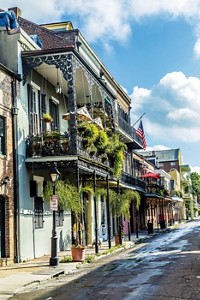Advertisement
Grab your lab coat. Let's get started
Welcome!
Welcome!
Create an account below to get 6 C&EN articles per month, receive newsletters and more - all free.
It seems this is your first time logging in online. Please enter the following information to continue.
As an ACS member you automatically get access to this site. All we need is few more details to create your reading experience.
Not you? Sign in with a different account.
Not you? Sign in with a different account.
ERROR 1
ERROR 1
ERROR 2
ERROR 2
ERROR 2
ERROR 2
ERROR 2
Password and Confirm password must match.
If you have an ACS member number, please enter it here so we can link this account to your membership. (optional)
ERROR 2
ACS values your privacy. By submitting your information, you are gaining access to C&EN and subscribing to our weekly newsletter. We use the information you provide to make your reading experience better, and we will never sell your data to third party members.
People
Pittcon 2007: Science In The Windy City
Chicago hosts the annual PITTSBURGH CONFERENCE, with an expanded program and new services
January 15, 2007
| A version of this story appeared in
Volume 85, Issue 3
THE PITTSBURGH CONFERENCE & Exposition on Analytical Chemistry & Applied Spectroscopy (Pittcon 2007) will hold its annual program from Sunday, Feb. 25, through Friday, March 2, at the McCormick Place Convention Center, in Chicago. The meeting brings together scientific and technical professionals to share the latest information about analytical science and instrumentation.
As it did last year, this year's Pittcon will open with a technical program on Sunday afternoon, starting at 1 PM. The afternoon will feature symposia, poster presentations, and contributed technical sessions, followed by an award presentation, plenary lecture, and a poster mixer.
New this year, the American Chemical Society Division of Analytical Chemistry (ANYL) will present its spring programming at Pittcon 2007 and not at the ACS spring national meeting (C&EN, July 3, 2006, page 43). ANYL will host four invited symposia, six contributed sessions, and an undergraduate poster session. The arrangement is expected to be mutually beneficial for Pittcon 2007 and the division: Analytical chemists won't have to choose which meeting to attend, and exhibitors will likely see increased traffic from conferees who would normally attend the ACS meeting.
As a new service for attendees, Pittcon 2007 is organizing interest-focused networking meetings. Each two-hour session will provide an opportunity for conferees to meet and discuss topics of mutual interest. There is no extra charge beyond the Pittcon registration fee; however, seating is limited. Visit the Attendee Services section of the meeting website, www.pittcon.org, to learn more.
The exposition will be open from Monday, Feb. 26, through Thursday, March 1. For up-to-date information about the meeting, visit the Pittcon 2007 website.
PITTCON at a Glance
Dates: Feb. 25-March 2
Location: Chicago
Website: www.pittcon.org
Information contacts:
Program, program@pittcon.org;
Exposition, expo@pittcon.org;
General Information, info@pittcon.org
TECHNICAL PROGRAM. The Pittcon 2007 technical program will feature workshops, invited symposia, contributed sessions, new product forums, and contributed oral and poster sessions. The major focus areas of this year's technical program include bioanalytical chemistry, biomedicine, neurochemistry, polymer science, informatics, pharmaceutical science, nanotechnology, environmental chemistry, forensic analysis, food analysis, applied molecular spectroscopy, mass spectrometry, and chemical separations. Visit the Pittcon 2007 website for the most current technical program.
Program highlights include a plenary lecture on Sunday afternoon by Charles M. Lieber, Mark Hyman Jr. Professor of Chemistry at Harvard University, on "Nanowire Nanoelectronic Devices for Detection of and Interfacing to Biological Systems."
SHORT COURSES. More than 100 courses will be offered beginning Saturday, Feb. 24, through Friday, March 2. Individual courses are designed for beginner, intermediate, or advanced students and cover a variety of subjects including atomic spectroscopy, hyphenated techniques, ion-mobility spectrometry, polymer analysis, and statistics and chemometrics. These courses provide continuing education opportunities led by experts in the field. Conference attendees who register for short courses before Jan. 26 can save up to 30% on each course. The conference general meeting registration fee is waived for those who take three or more courses. The meeting website has the complete list of course topics, instructors, schedules, and costs.
AWARDS. There will be a number of prestigious awards presented at Pittcon 2007. The 2007 Pittcon Heritage Award will be presented to David Schwartz, chairman of the board of Bio-Rad Laboratories, in Hercules, Calif. This award recognizes outstanding individuals whose entrepreneurial careers have shaped the instrumentation community, inspired achievement, promoted public understanding of the modern instrumentation sciences, and highlighted the role of analytical chemistry in world economies. Awardees also join the Pittcon Hall of Fame, which recognizes pioneers in the analytical instrumentation world.
The Pittsburgh Spectroscopy Award, sponsored by the Spectroscopy Society of Pittsburgh, will be given to Robert M. Corn, University of California, Irvine. The award recognizes an individual who has an established and outstanding record of contributions to the field of applied spectroscopy.
The Pittsburgh Analytical Chemistry Award, sponsored by the Society of Analytical Chemists of Pittsburgh, will be presented to Jonathan V. Sweedler, University of Illinois, Urbana-Champaign. This award recognizes significant contributions by a scientist to analytical chemistry.
Shana O. Kelley, University of Toronto, will receive the Pittsburgh Conference Achievement Award. This award recognizes outstanding achievements of an individual during the early stages of his or her independent scientific career.
The Award for Young Investigators in Separation Science, sponsored by Agilent Technologies and presented by ANYL, will be given to Christopher T. Culbertson, Kansas State University. This award recognizes and encourages outstanding contributions to the field of separation science by a young chemist or chemical engineer.
Norman J. Dovichi, University of Washington, will receive the Ralph N. Adams Award in Bioanalytical Chemistry. This award, sponsored by the Pittsburgh Conference and friends of Ralph Adams, recognizes an outstanding scientist who has advanced the field of bioanalytical chemistry through research, innovation, or education.
The Maurice F. Hasler Award will be given to D. Bruce Chase, DuPont, Wilmington, Del. The award, given every two years, recognizes notable achievements in spectroscopy resulting in significant applications of broad utility.
The Dal Nogare Award, sponsored by the Chromatography Forum of Delaware Valley, will be presented to John W. Dolan, LC Resources, Amity, Ore. This award was established to honor Stephen Dal Nogare, who died in 1968 after serving six months as president of the Chromatography Forum symposium. The recipient is chosen on the basis of his or her contributions to the fundamental understanding of the chromatographic process.
The Charles N. Reilley Award, sponsored by the Society for Electroanalytical Chemistry (SEAC), will be given to George S. Wilson, University of Kansas. This award recognizes outstanding research contributions in electroanalytical chemistry.
Mary Elizabeth (Beth) Williams, Pennsylvania State University, is this year's recipient of the SEAC Young Investigator Award, which is sponsored by Cypress Systems.
The Tomas B. Hirschfeld Award, sponsored by Büchi Labortechnik, Switzerland, recognizes outstanding contributions in the field of near-infrared spectroscopy. This year's award will be presented to Gerard Downey, Teagasc, Belfast, Northern Ireland.
The Bomem-Michelson Award, sponsored by ABB, honors scientists who have advanced the techniques of vibrational, molecular, Raman, or electronic spectroscopy. David F. Bocian, UC Riverside, is this year's awardee.
The Williams Wright Award, sponsored by the Coblentz Society, is presented annually to an industrial spectroscopist who has made significant contributions to vibrational spectroscopy. This year's award will be presented to Michael Carraba, Hach Homeland Security Technologies, Loveland, Colo.
EXPOSITION. The Pittcon 2007 Exposition will be open from Monday, Feb. 26, through Thursday, March 1. Exhibit hours will be from 9 AM to 5 PM on Monday through Wednesday and from 9 AM to 3 PM on Thursday. More than 800 exhibitors will showcase their latest analytical laboratory instrumentation, equipment, and services.
technical program
Invited Symposia
Sunday Afternoon
Nanoscale Self-Assembled Systems*
Emerging Technologies for Metabolomics
New Ideas & Approaches to Analytical Chemistry Education
Nonlinear Optical Vibrational Spectroscopic Studies on Biological Molecules
Practice of Ultrafast & Ultrahigh Pressure LC in Pharmaceutical Analysis
Single Cell Manipulation, Analysis & Use in Sensing
Monday Morning
Nanobiotechnology: From the Single Cell to the Single Molecule*
Advances in Mass Spectrometry of Synthetic Polymers
Investigating Neuronal Chemistry
Leadership Techniques That Engage Technical Staff To Provide Recognized Business Impact
Molecular Beacons: Ten Years Later
Monday Afternoon
Bioanalytical Applications of Photonic Nanostructures
Deciding on NIR or Mid-IR Spectroscopy for Process Monitoring
Nanoconductors & Chemical Sensing
New Frontiers in Scanning Electrochemical Microscopy: Probing Biological & Nanostructured Interfaces
State-of-the-Art Cellular Targeting & Cellular Drug Discovery
18th Annual James L. Waters Symposium
Tuesday Morning
Achievements & Challenges in Mass Spectrometry
High-Throughput Screening of Biological & Chemical Sensor Materials
Modern Liquid Chromatography
Novel Biospectroscopy for Amyloid Diseases
Novel Supported Membranes & Membrane Arrays for Biosensing Applications
Ultraviolet Resonance Raman Spectroscopy: It's Ready for Prime Time! What's Holding It Back?
Tuesday Afternoon
Tropical Disease Detection: Analytical Chemistry for the Developing World*
Advances & Challenges in Forensic Applications of Mass Spectrometry
Analytical Characterization of Nanoparticles & Nanomaterials
Chemical Sensors for Environmental Monitoring
Genotoxic Impurities: Assessment, Quantitation & Regulations
In Vivo Sampling
Surface-Enhanced Raman Scattering (SERS) from Nanoparticles for Analysis & Bioanalysis
Wednesday Morning
Science of Global Climate Change*
Advances in Open-Path Atmospheric Monitoring
Detection of Terrorist Weapons: Chemical Weapons
Functional Glycomics: Decoding Glycans through Mass Spectrometry or Microarrays?
Ion Mobility: Recent Developments in Instrumentation & Applications
Quantitatively Investigating the Communication Skills between Cells & Tissues
Wednesday Afternoon
Arsenic: Transformation, Speciation & Toxicity
Detection of Terrorist Weapons: Biological Weapons
From Micro to Nano in Analytical Instrumentation
Quantitative Proteomics & Metabolomics for Systems Biology
Spectroscopic Insights into Separation Processes
Thursday Morning
Beryllium Analysis: Occupational Exposures
Emerging Process Analytical Technologies (PAT) and the Use of PAT in Process Understanding & Product Development
Food Safety
Neurochemical Monitoring: From Impulses to Outcomes
What Will Control the Optimal Channel Size for Nanoscale Separations?
Thursday Afternoon
Bioanalytical Applications of Single-Molecule Detection & Spectroscopy
Drug Screening Assays: Opportunities for Analytical Chemistry in Drug Discovery
Pharmaceutical Analytical Laboratory Method Transfer & Variability Reduction: Solutions for QC & Development
Use of Mid-Infrared Focal Planar Arrays in Imaging & Spectroscopy
Using Electric Field Gradients to Concentrate & Separate Biomolecules
Contributed Sessions
Sunday Afternoon
Teaching Analytical Chemistry at the Boundaries*
Drops: Bioanalysis without Walls
Problems & Solutions of Land Mine & Improvised Explosive Devices
Monday Morning
Success Strategies for Undergraduate Research*
High-Throughput Hyphenated MS Techniques for Pharmaceuticals
Nonlinear Optical Vibrational Spectroscopic Studies on Biological Molecules
Monday Afternoon
Nanoscale Self-Assembled Systems*
Spectroscopic Techniques for Polymer Characterization
Detection & Sourcing of Counterfeit Pharmaceuticals & Illicit Drugs
Vacuum Ultraviolet Photoionization for Analytical Mass Spectrometry
Tuesday Morning
Clinical & Biomedical Applications of Microfluidics: Toward Point-of-Care Testing*
Identification of Impurities Using Liquid Chromatography Hyphenated with Tandem Mass Spectrometry
Ionophore-Based Chemical Sensors I
Pharmaceutical Analysis: Analytical Techniques for the Isolation, Characterization & Prediction of Particulate Matter in Drug Products & Excipients
Tuesday Afternoon
Achievements & Challenges in Mass Spectrometry
Advanced Pyrolysis GC/MS Techniques Applied to Material Characterization
Ionophore-Based Chemical Sensors II
Modern Liquid Chromatography
Wednesday Morning
Application of Liquid Chromatography & Tandem Mass Spectrometry in the Analysis of Active Pharmaceutical Ingredients
Pharmaceutical Reference Standards I
Specialty Gases
Wednesday Afternoon
Analytical Methods for Determining Environmental Changes*
Integrated Analytical Approaches for Structure Identification: Analysis of Impurities & Degradants
Pharmaceutical Reference Standards II
Progress in LIBS Chemical Analysis: New Paradigms in Sample Engineering, Measurements & Applications
Thursday Morning
Nanobiotechnology: From the Single Cell to the Single Molecule*
Advances in Spectroscopic Instrumentation: The Intersection of Photonics & Spectroscopy
Enhanced Sensing Approaches for Food & Water Defense
Immunoassays & Related Techniques for Emerging Environmental Contaminants
Perspectives of Direct Solids Analysis Using Atomic & Mass Spectrometry
Thursday Afternoon
Advances in the Characterization of Omega 3 Oils & Associated Functional Foods
Calibration Gas Mixtures: More Important Than Ever






Join the conversation
Contact the reporter
Submit a Letter to the Editor for publication
Engage with us on Twitter